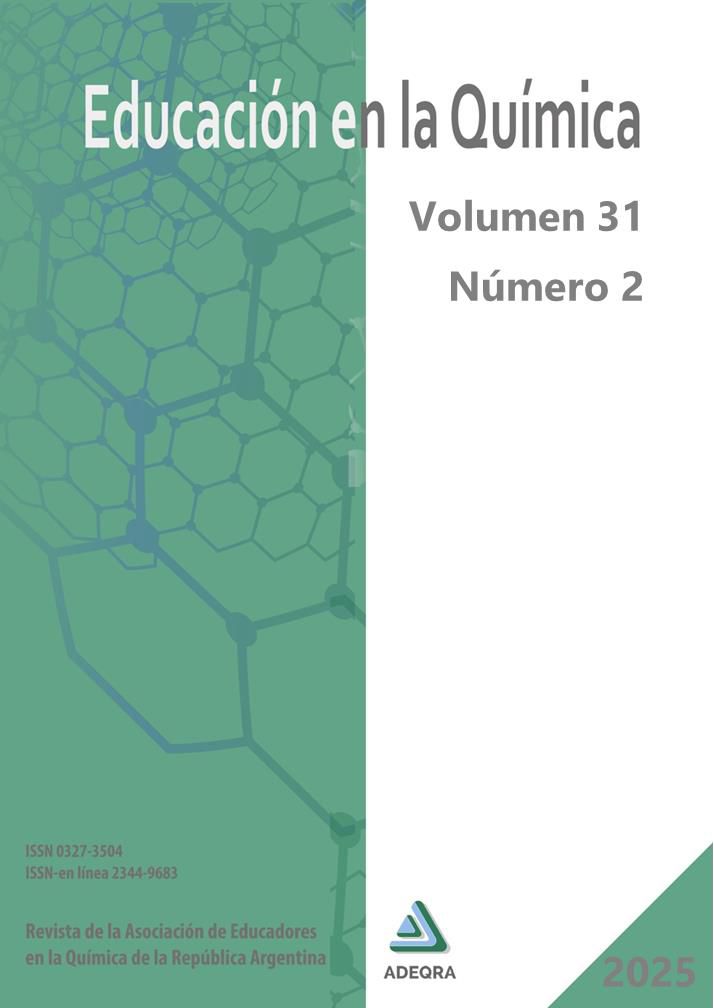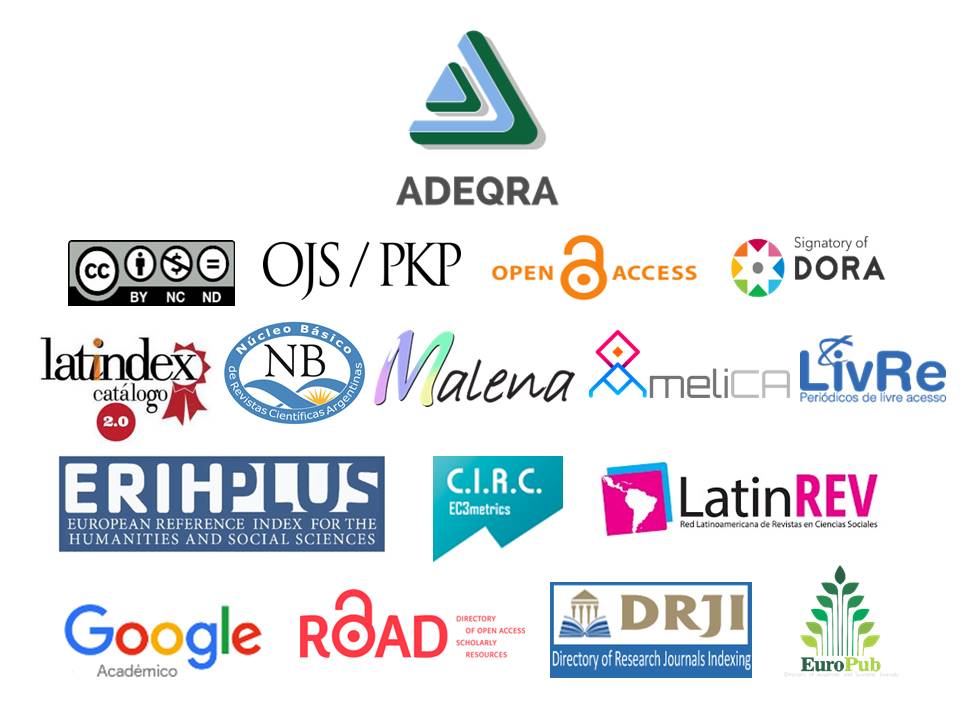Elementary and High School Teachers’ (Mis)Conceptions on the Nature of Matter
Keywords:
particulate nature of matter, misconceptions, elementary school teachers, high school teachersAbstract
This study explores the conceptions about the nature of matter and the kinetic-corpuscular theory among 99 primary and secondary school teachers in Buenos Aires. They participated in activities such as multiple-choice questions and problem-solving. The results revealed misconceptions regarding phase changes, the spacing between particles, and the relationship between kinetic energy and particle motion. While secondary school teachers showed a better understanding of the particulate nature of matter, misconceptions such as the belief that particles change size during phase transitions or that there is no space between particles in the solid state prevailed. Primary school teachers tended toward intuitive and continuous models of matter. These findings highlight the need for interventions to address these misconceptions and improve teacher training in fundamental concepts about matter.
References
Abu-Hola, I. (2004). Biological science misconceptions amongst teachers and primary students inJordan: diagnosis and treatment. Advances in Learning, Commerce and Security, 1, 109–118.
Albanese, A., y Vicenti, M. (1997). Why do we believe that an atom is colourless? Reflections about the teaching of the particle model. Science & Education, 6, 251–261. https://doi.org/10.1023/A:1017933500475
Andersson, B. (1990). Pupils’ Conceptions of Matter and its Transformations (age 12-16). Studies in Science Education, 18(1), 53-85. https://doi.org/10.1080/03057269008559981
Ayas, A., Özmen, H., y Çalik, M. (2009). Students’ conceptions of the particulate nature of matter at secondary and tertiary level. International Journal of Science and Mathematics Education, 8, 165-184. https://doi.org/10.1007/s10763-009-9167-x
Aydin, A., y Altuk, Y. G. (2013). Turkish Science Student Teachers’ Conceptions on the States of Matter. International Education Studies, 6(5), p104. https://doi.org/10.5539/ies.v6n5p104
Ben-Zvi, R., Eylon, B. S. y Silberstein, J. (1986). Is an atom of copper malleable? Journal of chemical education, 63(1), 64-66. https://doi.org/10.1021/ed063p64
Boz, Y. (2006). Turkish Pupils’ Conceptions of the Particulate Nature of Matter. Journal of Science Education and Technology, 15(2), 203-213. https://doi.org/10.1007/s10956-006-9003-9
Bucat, R. (2004). Pedagogical content knowledge as a way forward: applied research in chemistry education. Chemistry Education Research and Practice, 5(3), 215-228. https://doi.org/10.1039/B4RP90025A
Chandrasegaran, A. L., Treagust, D. F., y Mocerino, M. (2007). The development of a two-tier multiple-choice diagnostic instrument for evaluating secondary school students’ ability to describe and explain chemical reactions using multiple levels of representation. Chemistry Education Research and Practice, 8(3), 293-307. https://doi.org/10.1039/B7RP90006F
Chophel, Y. (2022). Remediating misconceptions related to particulate nature of matter using video animation: an action research. https://doi.org/10.5281/ZENODO.6496773
Coetzee, A., y Imenda, S.N. (2012). Alternative conceptions held by first year physics students at a South African university of technology concerning interference and diffraction of waves. Research in Higher Education Journal, 1-13.
Duit, R. (2007). Science education research internationally: Conceptions, research methods, domains of research. Eurasia Journal of Mathematics, Science and Technology Education, 3(1), 3-15. https://doi.org/10.12973/ejmste/75369
Duit, R., y Treagust, D. F. (2003). Conceptual change: A powerful framework for improving science teaching and learning. International Journal of Science Education, 25(6), 671–688. https://doi.org/10.1080/09500690305016
Eryilmaz, A. (2002).Effects of Conceptual Assignments and Conceptual Change Discussions on Students’ Misconceptions and Achievement Regarding Force and Motion. Journal of Research in Science Teaching, 39(10), 1001–1015.
Facultad de Ciencias Exactas y Naturales (UBA) (2025). Profesorados en ciencias. https://exactas.uba.ar/ensenanza/carreras-de-grado/profesorados-en-ciencias/
Gobierno de la Ciudad de Buenos Aires (2025a). Profesorados de Educación Secundaria y/o Superior. https://buenosaires.gob.ar/profesorados-y-formacion-en-educacion/profesorados-de-educacion-secundaria-yo-superior
Gobierno de la Ciudad de Buenos Aires (2025b). Profesorado de Educación Primaria. https://buenosaires.gob.ar/profesorados-y-formacion-en-educacion/profesorado-de-educacion-primaria
Griffiths, A. K., y Preston, K. R. (1992). Grade-12 students’ misconceptions relating to fundamental characteristics of atoms and molecules. Journal of Research in Science Teaching, 29(6), 611-628. https://doi.org/10.1002/tea.3660290609
Haidar, A. H., y Abraham, M. R. (1991). A comparison of applied and theoretical knowledge of concepts based on the particulate nature of matter. Journal of Research in Science Teaching, 28(10), 919-938. https://doi.org/10.1002/tea.3660281004
Hala, Y., Syahdan, U. A., Pagarra, H., y Saenab, S. (2018). Identification of Misconceptions on Cell Concepts among Biology Teachers by Using CRI Method. Journal of Physics: Conference Series ,1028.
Harrison, A. G. (2001). How do Teachers and Textbook Writers Model Scientific Ideas for Students? Research in Science Education, 31(3), 401-435. https://doi.org/10.1023/A:1013120312331
Harrison, A. G., y Treagust, D. F. (2003). The Particulate Nature of Matter: Challenges in Understanding the Submicroscopic World. En J. K. Gilbert, O. Jong, R. Justi, D. F. Treagust, y J. H. Driel (Eds.), Chemical Education: Towards Research-based Practice (Vol. 17, pp. 189-212). Kluwer Academic Publishers. https://doi.org/10.1007/0-306-47977-X_9
Johnson, P. (1998). Progression in children’s understanding of a basic particle theory: A longitudinal study. International Journal of Science Education, 20(4), 393–412. https://doi.org/10.1080/0950069980200402
Kapici, H. O., Akcay, H. (2016). Particulate Nature of Matter Misconceptions Held by Middle and High School Students in Turkey. European Journal of Education Studies, 2, 43-58.
Kolomuç, A., y Tekin, S. (2011). Chemistry Teachers’ Misconceptions Concerning Concept of Chemical Reaction Rate. International Journal of Physics and Chemistry Education, 3(2), Article 2. https://doi.org/10.51724/ijpce.v3i2.194
Krnel, D., Watson, R., Glazar, S. A. (1998). Survey of research related to the development of the concept of matter. International Journal of Science Education, 20, 257-289. https://doi.org/10.1080/0950069980200302
Lee, O., Eichinger, D. C., Anderson, C. W., Berkheimer, G. D., y Blakeslee, T. D. (1993). Changing middle school students’ conception of matter and molecules. Journal of Research in Science Teaching, 30(3), 249-270. https://doi.org/10.1002/tea.3660300304
Lemma, A. (2012). Diagnosing the diagnostics: misconceptions of twelfth grade students on selected chemistry concepts in two preparatory schools in eastern ethiopia. African Journal of Chemical Education, 2(2), 16-31. https://www.ajol.info/index.php/ajce/article/view/82443
Limón, M. y Mason, L. (2002). Reconsidering Conceptual Change: Issues in Theory and Practice. Kluwer Academic Publicshers.
Nakhleh, M. B. (1992). Why some students don’t learn chemistry: Chemical misconceptions. Journal of Chemical Education, 69(3), 191. https://doi.org/10.1021/ed069p191
National Research Council (2012). Discipline-Based Education Research: Understanding and Improving Learning in Undergraduate Science and Engineering. En: S. R. Singer, N. R. Nielsen y H. A. Schweingruber (Ed.). Committee on the Status, Contributions, and Future Directions of Discipline-Based Education Research, Board on Science Education, Division of Behavioral and Social Sciences and Education. The National Academies Press. https://nap.nationalacademies.org/read/13362/chapter/8?term=58
Özalp, D. y Kahveci, A. (2015). Diagnostic assessment of student misconceptions about the particulate nature of matter from ontological perspective. Chemistry Education Research and Practice, 16(3), 619-639. https://doi.org/10.1039/C5RP00096C
Özmen, H. (2013). A Cross-National Review of the Studies on the Particulate Nature of Matter and Related Concepts. International Journal of Physics and Chemistry Education, 5(2), 81-110. https://doi.org/10.51724/ijpce.v5i2.77
Pozo, J.I. y Gómez Crespo, M.A. (2005). The embodied nature of implicit theories: the consistency of ideas about the nature of matter. Cognition and Instruction, 23(3), 351-387. https://doi.org/10.1207/s1532690xci2303_2
Rai, A.K. y Kumar, S. (2019). Misconceptions in Science: A Theoretical Analysis. International Journal of Emerging Technologies and Innovative Research, 6(6), 543-551.
Rajendra, C. y Khandagale, V. (2022). Intricacies in Identification of Biological Misconceptions. Scholarly Research Journal for Interdisciplinary Studies, 9(70),16810-16819.
Reiner, M., Slotta, J., Chi, M., y Resnick L. (2000) Naive Physics Reasoning: A Commitment to Substance-Based Conceptions. Cognition and Instruction, 18, 1–34. https://doi.org/10.1207/S1532690XCI1801_01
Schnotz, W., V Osniadou, S. y Carretero, M. (1999) New perspetives on conceptual change. Oxford: Pergamon
Sopandi, W., Latip, A. y Sujana, A. (2017). Prospective Primary School Teachers’ Understanding on States of Matter and Their Changes. Journal of Physics: Conference Series, 812, 012075. https://doi.org/10.1088/1742-6596/812/1/012075
Sreypouv, O. y Shimizu, K. (2017). Exploring misconceptions about the characteristics of solid, liquid, and gas among junior high school students in Kampot province, Cambodia. Unnes Science Education Journal, 6. https://doi.org/10.15294/USEJ.V6I3.20351
Stojanovska, M., Šoptrajanov, B. y Petrusevski, V. (2012). Addressing misconceptions about the Particulate Nature of Matter among Secondary-School and High-School Students in the Republic of Macedonia. Creative Education, 3, 619-631. https://doi.org/10.4236/ce.2012.35091
Svandova, K. (2014). Secondary School Students’ Misconceptions about Photosynthesis and PlantRespiration: Preliminary Results. Eurasia Journal of Mathematics, Science and Technology Education, 10(1), 59-67. https://doi.org/10.12973/eurasia.2014.1018a
Tatar, E. (2011). Prospective primary school teachers’ misconceptions about states of matter. Educational Research and Reviews, 6(2), 197-200.
Treagust, D., Chandrasegaran, A., Crowley, J., Yung, B., Cheong, I. y Othman, J. (2009). Evaluating students’ understanding of kinetic particle theory concepts relating to the states of matter, changes of state and diffusion: A cross-national study. International Journal of Science and Mathematics Education, 8, 141-164. https://doi.org/10.1007/s10763-009-9166-y
Treagust, D.F. y Duit, R. (2008). Conceptual change: a discussion of theoretical, methodological and practical challenges for science education. Cultural Studies of Science Education, 3, 297–328. https://doi.org/10.1007/s11422-008-9090-4
Valanides, N. (2000). Primary student teachers’ understanding of the particulate nature of matter and its transformations during dissolving. Chemistry Education Research and Practice, 1(2), 249-262. https://doi.org/10.1039/A9RP90026H
West, L. H. y Pines, A. L. (1985). Cognitive structure and conceptual change. Sydney Academic Press.
Published
How to Cite
Issue
Section
License
Copyright (c) 2025 Valeria Edelsztein

This work is licensed under a Creative Commons Attribution-NonCommercial-NoDerivatives 4.0 International License.



